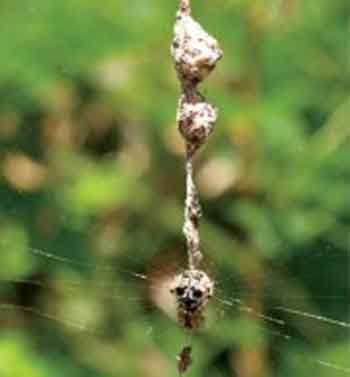Spider Builds Body Double to Catch Prey

Orb spiders of the genus Cyclosa have a flair for home decor. They adorn their webs with prey remains or egg sacs wrapped in silk, positioning those packets in a vertical line above and below their own central waiting place. But the ornaments are no product of feng shui.
In fact, a new study shows, they’re decoys—and the orb spider is thus the first animal proven to build body doubles for fooling predators.
Studying C. mulmeinensis in Taiwan, on a tropical island off the coast, Ling Tseng and her graduate adviser at the time, I-Min Tso of Tunghai University in Taichung City, confirmed that the decorations match the web owner’s body in size and color. Then they set up video cameras in front of webs to record the behavior of wasps, the spiders’ main predators.
The biologists found that wasps were twice as likely to attack webs with at least two packets as to attack webs with one or fewer—the ornamentation being rather conspicuous. Yet on the well-festooned webs, wasps tended to attack the decoys rather than the spider, and spiders there suffered only 40 percent as many bodily attacks as did spiders on plain webs. The odds indicate that building decoys gives spiders only a slight advantage—but Tseng and Tso assert it’s enough for natural selection to maintain the behavior.
The research was detailed in the journal Animal Behaviour.
- Image Gallery: Creepy Spiders
- Oldest Known Spier Webs Discovered
- The Secret Weapons of Bugs
This article was provided to LiveScience by Natural History Magazine.
Get the world’s most fascinating discoveries delivered straight to your inbox.


